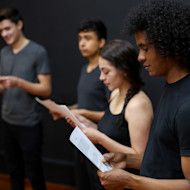Degrees in Fine Arts and Studio Arts
Fine arts is a creative discipline that encompasses painting, sculpture, photography, and more. A fine arts degree provides a comprehensive education in both practical and theoretical aspects of the visual arts, honing skills in critical thinking, creative techniques, and art history.
Notable universities offering fine arts degrees include Ohio Wesleyan University, which emphasizes individualized mentorship, and The New School, known for its interdisciplinary approach. At the University at Buffalo, students can delve into digital and media arts, while Adelphi University offers specialized tracks in studio art.
With the knowledge and skills you gain from a fine arts degree, you could pursue a career as a professional artist, educator, curator, art therapist, or more, making significant contributions to the arts community.
of the US economy comes from arts and cultural production - U.S. Bureau of Economic Analysis, 2023
revenue in the US from public auctions of fine art (2024)
trade value of exported works of art out of the US (2024)

- Compare your matches
- Apply with ease
- Speak with experts
Frequently Asked Questions for Visual and Performing Arts Students
Will I need to submit an audition or portfolio to apply for a visual or performing arts program in the US?
Yes, most visual and performing arts programs in the US require applicants to submit a portfolio or audition as part of the application process. The specific requirements vary by program and university, but typically, visual arts applicants will need to provide a portfolio showcasing their best work, while performing arts applicants will need to audition either in person or via video submission.
What is the balance of practice-based work and theoretical work in arts degrees?
The balance of practice-based and theoretical work in arts degrees can vary widely depending on the program and institution. Generally, these programs combine both practical and theoretical components to provide a well-rounded curriculum. For example, visual arts programs might include studio classes where students create art, along with courses in art history and theory. Performing arts programs can combine performance practice with studies in dramatic literature, performance theory, and the history of the performing arts.
What skills will I develop in my arts or performing arts degree?
In an arts or performing arts degree, students typically develop a comprehensive set of skills that prepare them for a wide range of professional opportunities. Students can develop their expertise in different artistic techniques and mediums, such as painting, sculpture, acting, or dance. Apart from technical skills, creative thinking is also encouraged, enabling students to generate original ideas and innovative solutions. Critical analysis is another key skill, as students learn to analyze art and performance, understand historical and cultural contexts, and engage in constructive critique.
Strong communication skills, both verbal and written, are also refined, which are essential for explaining concepts and collaborating effectively with peers and professionals.
Students also learn about professional practice, including portfolio development, audition preparation, and networking, which are crucial for building a career in the arts. Project management experience is developed through the planning, execution, and presentation of projects, often both independently and as part of a team, preparing students for the logistical and collaborative aspects of professional artistic work.
Is it possible to do internships or work placements in a visual or performing arts program?
Yes, many visual and performing arts programs offer opportunities for internships or work placements. These experiences allow students to gain practical, hands-on experience in their field of study, build professional networks, and enhance their resumes. Internships can take place in various settings, such as galleries, theaters, production companies, and arts organizations.
What type of careers do visual and performing arts graduates go into?
Graduates of visual and performing arts programs have a wide range of career paths available, reflecting the diverse skills and experiences gained during their studies. In the visual arts, graduates often pursue careers as artists, illustrators, graphic designers, or art directors, and some may work as curators or gallery managers. Those with a passion for education might become art teachers or professors, sharing their knowledge and inspiring the next generation of artists. In the performing arts, career options include acting, dancing, music performance, choreography, directing, and stage management. Some graduates also explore roles in drama, dance, or music therapy, using the arts as a therapeutic tool.
The creative industries, such as film, television, advertising, and multimedia production, offer additional opportunities for graduates to apply their skills in dynamic environments. Finally, arts administration is another field where graduates can excel, taking on roles in arts organizations, cultural institutions, and nonprofits as managers, program coordinators, and development officers.











